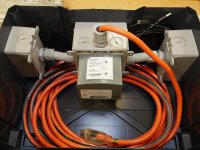GPowers
Member
- Joined
- Mar 1, 2010
- Messages
- 2,326
Cheese said:FWIW...just got a note back from International Configuration and they have the 70020-BLK receptacles in stock at $6.46 each. [smile]
However, they do have a $50 minimum charge. [sad]
[member=44099]Cheese[/member] Do a group buy. Still a lot cheaper, half the price, than the ones I bought.



